“How’s Mo?”
As one might imagine, we hear this question frequently, and
we are thankful to be able to answer that overall he is doing
very well. Despite the challenges, the weeks remain filled
with a lot of laughter. At the core of recent progress
is an improvement in sleep. He is falling asleep earlier
and reaching a deeper sleep more quickly almost every night
- especially during and shortly after his breaks from chemo
(six weeks on/two weeks off). He generally wakes well
rested between 9 and 10. This has led to improvements
in his energy level, strength, balance, ability to concentrate,
and general happiness. Despite our seemingly endless efforts
to adjust his meds to improve his sleeping, it appears that
the most potent tonic has been what Dr. Anne calls the tincture
of time.
 But,
to be specific, the question “How’s Mo?” has
a complex answer. As the dust of the Bone Marrow Transplant
(BMT) settles, we can see that Mo has several distinct challenges
- each with its own issues, recovery schedule and recovery potential.
The list goes something like this: But,
to be specific, the question “How’s Mo?” has
a complex answer. As the dust of the Bone Marrow Transplant
(BMT) settles, we can see that Mo has several distinct challenges
- each with its own issues, recovery schedule and recovery potential.
The list goes something like this:
Cure
Eating
Strength, Energy, Balance
Hearing and Education |

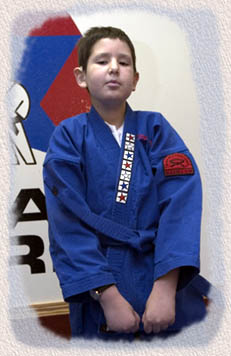 Back in uniform to pose for the UWCH monthly
magazine
Back in uniform to pose for the UWCH monthly
magazine |
Cure
 For
a while yet (perhaps another year), Mo will continue to have an
MRI scan every 2-3 months. Families dealing with pediatric
brain tumors (PBTs) learn to adapt their lives to the interval of
time between MRIs. Mo's next MRI is on Monday May 17. His
previous MRI showed a new abnormality in a different part of his
cerebellum. The docs in Madison and Memphis feel that it is
not a tumor, though if there is something you will never find in
the Land of Cancer Treatment, it is certainty, therefore, we are
all a bit nervous. For
a while yet (perhaps another year), Mo will continue to have an
MRI scan every 2-3 months. Families dealing with pediatric
brain tumors (PBTs) learn to adapt their lives to the interval of
time between MRIs. Mo's next MRI is on Monday May 17. His
previous MRI showed a new abnormality in a different part of his
cerebellum. The docs in Madison and Memphis feel that it is
not a tumor, though if there is something you will never find in
the Land of Cancer Treatment, it is certainty, therefore, we are
all a bit nervous.
 A
Dilemma A
Dilemma
 Mo
continues to be on a home-based chemotherapy regime, but here life
has presented us with a dilemma. One of the medicines which
Mo is taking has shown to be very effective against medulloblastoma
cells in laboratory tests. Many of the Oncology docs around
the country are very encouraged by these results and are moving
forward with using the drug as part of a treatment plan. However
the drug can also have nasty side-effects including depression,
sleep disruption, and stomach problems The treatment plan,
which is untested, designates taking the medication two weeks on,
two weeks off, continuously for about 1 year. Mo has already
experienced quite a few side-effects, so we have drastically reduced
the dose to a level which he finds tolerable (which is about the
very least amount we could give him). As often happens in
the ordeal of PBTs, we have reached a point where the path branches
(one path, a low dose, real benefit unknown; the other path, stop
the medication, and possibly lose out on it's benefits) and we have
very little knowledge with which to make a decision about which
branch to follow. While we know some of the risks, nobody
knows what the traveling conditions will be like or what will happen
along the way. With little knowledge we try to balance risk
with quality of life and forge ahead. There is no standing
still though I often wish we could. Mo
continues to be on a home-based chemotherapy regime, but here life
has presented us with a dilemma. One of the medicines which
Mo is taking has shown to be very effective against medulloblastoma
cells in laboratory tests. Many of the Oncology docs around
the country are very encouraged by these results and are moving
forward with using the drug as part of a treatment plan. However
the drug can also have nasty side-effects including depression,
sleep disruption, and stomach problems The treatment plan,
which is untested, designates taking the medication two weeks on,
two weeks off, continuously for about 1 year. Mo has already
experienced quite a few side-effects, so we have drastically reduced
the dose to a level which he finds tolerable (which is about the
very least amount we could give him). As often happens in
the ordeal of PBTs, we have reached a point where the path branches
(one path, a low dose, real benefit unknown; the other path, stop
the medication, and possibly lose out on it's benefits) and we have
very little knowledge with which to make a decision about which
branch to follow. While we know some of the risks, nobody
knows what the traveling conditions will be like or what will happen
along the way. With little knowledge we try to balance risk
with quality of life and forge ahead. There is no standing
still though I often wish we could.
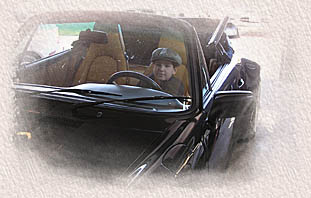
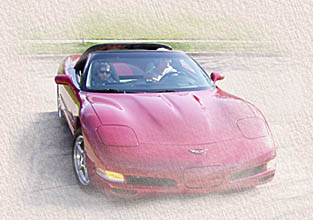
Tooling
around in Cousin Mike's Porsche and neighbor Joel's Corvette
Eating
 While
there are developments in eating, none of them have to do with actually
eating. Mo continues to depend entirely on enteral (feeding
tube) feeding for his nutrition. Unlike some of the other children
with brain tumors who's parents we are in contact with, Mo has never
been able to handle large "servings" of the liquid food
(bolus feeding), nor have we been able to feed him at a rate higher
than 85ml/hr (and even that causes problems). As a result, Mo needs
to receive food pretty much continuously. While
there are developments in eating, none of them have to do with actually
eating. Mo continues to depend entirely on enteral (feeding
tube) feeding for his nutrition. Unlike some of the other children
with brain tumors who's parents we are in contact with, Mo has never
been able to handle large "servings" of the liquid food
(bolus feeding), nor have we been able to feed him at a rate higher
than 85ml/hr (and even that causes problems). As a result, Mo needs
to receive food pretty much continuously.
 On
4/26 Mo had an xray study of his upper intestinal tract,called an
upper GI, to see how well his stomach was emptying. We found that
he had serious gastroesophageal reflux (which excited the GI doc
but was no surprise to us), but we also found that he has "Superior
Mesenteric Artery Syndrome". This is a relatively rare condition
in which the stomach is squeezed by a few arteries that surround
the stomach, making the stomach difficult to empty. The squeezing
is less severe when Mo lies on his side, which is why we are able
to feed Mo at a higher rate at night with fewer problems. The
GI doc explained that the condition is caused by a sudden weight
loss, which causes the loss of the fat which provides a cushion
and support of the arteries so they don't impinge upon the stomach.
Mo actually gained quite a bit of weight during his bone marrow
transplant (he was on IV feeding or TPN), but has lost all of it
and then some since then. So at least we know why he has had
some trouble with the tube feeding. The other helpful discovery
has been the use of an "elemental" liquid food, which
is much easier to digest. He has significantly fewer problems
with feeling full since he started using it. On
4/26 Mo had an xray study of his upper intestinal tract,called an
upper GI, to see how well his stomach was emptying. We found that
he had serious gastroesophageal reflux (which excited the GI doc
but was no surprise to us), but we also found that he has "Superior
Mesenteric Artery Syndrome". This is a relatively rare condition
in which the stomach is squeezed by a few arteries that surround
the stomach, making the stomach difficult to empty. The squeezing
is less severe when Mo lies on his side, which is why we are able
to feed Mo at a higher rate at night with fewer problems. The
GI doc explained that the condition is caused by a sudden weight
loss, which causes the loss of the fat which provides a cushion
and support of the arteries so they don't impinge upon the stomach.
Mo actually gained quite a bit of weight during his bone marrow
transplant (he was on IV feeding or TPN), but has lost all of it
and then some since then. So at least we know why he has had
some trouble with the tube feeding. The other helpful discovery
has been the use of an "elemental" liquid food, which
is much easier to digest. He has significantly fewer problems
with feeling full since he started using it.
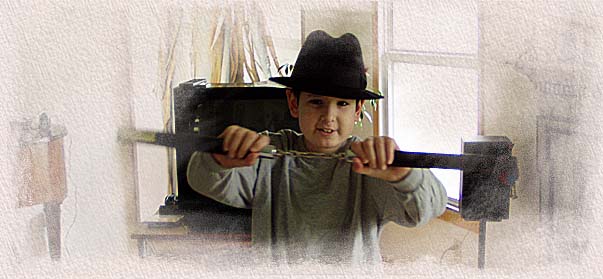
Strength, Energy, Balance
 As
we move further from BMT and sleeping improves, more stuff gets
done. Mo actually walks around the house a little bit without
any assistance, although he is much safer when he uses his walker.
We all hold our breath when he does this, and in his eagerness
to walk he has taken a couple of nasty falls. He fell down
2 stairs in the garage on the way to a party at school, the pain
and anger of which caused him to miss the party. A fall on
Mother's day put him back in the wheelchair for the last week with
a very sore knee. While he is out of the wheelchair alittle,
the pain and weakness persist, so we will probably have to have
the knee checked out. Unfortunately it looks like this will
set his walking progress back a few weeks. As
we move further from BMT and sleeping improves, more stuff gets
done. Mo actually walks around the house a little bit without
any assistance, although he is much safer when he uses his walker.
We all hold our breath when he does this, and in his eagerness
to walk he has taken a couple of nasty falls. He fell down
2 stairs in the garage on the way to a party at school, the pain
and anger of which caused him to miss the party. A fall on
Mother's day put him back in the wheelchair for the last week with
a very sore knee. While he is out of the wheelchair alittle,
the pain and weakness persist, so we will probably have to have
the knee checked out. Unfortunately it looks like this will
set his walking progress back a few weeks.
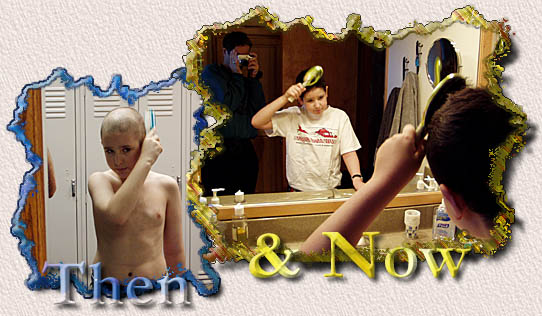 |
 When
the warm weather graces us with its presence, Mo sits outside and
squirts Mabel with water, plays some gentle sports, or just enjoys
the fresh air. On 4/21 he attended school to show off his beautiful
new head of hair in his class picture. I brushed his hair as
we prepared to go. He commented that this was the first time
in a year and a half that he has had enough hair to brush. This
progress marker hadn't escaped my notice either. When
the warm weather graces us with its presence, Mo sits outside and
squirts Mabel with water, plays some gentle sports, or just enjoys
the fresh air. On 4/21 he attended school to show off his beautiful
new head of hair in his class picture. I brushed his hair as
we prepared to go. He commented that this was the first time
in a year and a half that he has had enough hair to brush. This
progress marker hadn't escaped my notice either.
 In
January, when he started PT, Mo was not able to sit on the floor -
his muscles were stiff and it hurt to bend his knees. Now the
living room is once again cluttered with Legos and toy cars and the
music of Mo's playing and pretending can once again be heard in our
house. Mabel, who has been amazingly gentle with Mo throughout
this ordeal, again has someone besides Becky and I to disturb her
laziness. In
January, when he started PT, Mo was not able to sit on the floor -
his muscles were stiff and it hurt to bend his knees. Now the
living room is once again cluttered with Legos and toy cars and the
music of Mo's playing and pretending can once again be heard in our
house. Mabel, who has been amazingly gentle with Mo throughout
this ordeal, again has someone besides Becky and I to disturb her
laziness.
Hearing
 It
has occurred to me that, under normal circumstances, we would probably
be devastated if our child had a sudden severe hearing loss. But
in this exceptional situation, we didn't even have time to think
about it when it occurred. It's kind of like Star Wars, when
Luke Skywalker's hand is severed during a fight, but he can't be
bothered with minor detail like that, he just keeps on fighting.
But now that that battle is over and we are addressing the
wounds, we have realized that unlike Luke, who lives far enough
into the future to receive a bionic replacement, technology is not
advanced enough to help Mo communicate thoroughly - especially in
school where he has to absorb a lot of information in a short time.
There is an answer, but it is low tech: sign language. It
has occurred to me that, under normal circumstances, we would probably
be devastated if our child had a sudden severe hearing loss. But
in this exceptional situation, we didn't even have time to think
about it when it occurred. It's kind of like Star Wars, when
Luke Skywalker's hand is severed during a fight, but he can't be
bothered with minor detail like that, he just keeps on fighting.
But now that that battle is over and we are addressing the
wounds, we have realized that unlike Luke, who lives far enough
into the future to receive a bionic replacement, technology is not
advanced enough to help Mo communicate thoroughly - especially in
school where he has to absorb a lot of information in a short time.
There is an answer, but it is low tech: sign language.
 As
we have looked into options for hearing disabled students, we have
realized that learning some sign language will allow Mo to fully
understand and participate in the classroom. Fortunately,
there are target schools in Madison (one each of elementary, middle,
and high school) which provide comprehensive programming and staffing
for hearing impaired students. We have only recently realized
that we need to incorporate this into our lives, so plans are still
being formulated. Look for sign language lessons at the Egfelt
house in the near future. Mo's hearing loss is one of several
sources of frustration as we navigate this ordeal. There are
many times when it is difficult or impossible for him to participate
in conversations in our home, much less out of the house. We
have already started using finger spelling to spell words which
Mo has trouble understanding, and I look forward to learning sign
language and eliminating some (maybe even all) of these frustrations. As
we have looked into options for hearing disabled students, we have
realized that learning some sign language will allow Mo to fully
understand and participate in the classroom. Fortunately,
there are target schools in Madison (one each of elementary, middle,
and high school) which provide comprehensive programming and staffing
for hearing impaired students. We have only recently realized
that we need to incorporate this into our lives, so plans are still
being formulated. Look for sign language lessons at the Egfelt
house in the near future. Mo's hearing loss is one of several
sources of frustration as we navigate this ordeal. There are
many times when it is difficult or impossible for him to participate
in conversations in our home, much less out of the house. We
have already started using finger spelling to spell words which
Mo has trouble understanding, and I look forward to learning sign
language and eliminating some (maybe even all) of these frustrations.
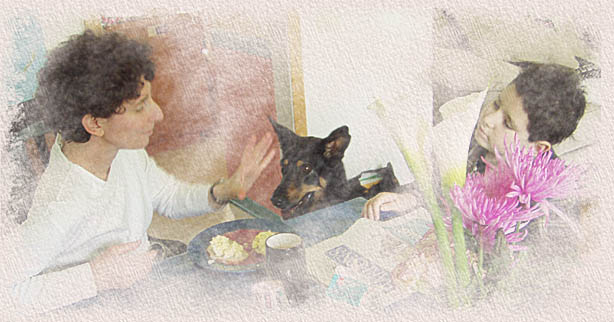
Final Thoughts
 As
Don Miguel Ruiz points out so insightfully in his excellent book,
The Four Agreements, we all wander through life
submerged in our own dreams. All of our hopes, aspirations
and expectations are tightly knit into our beliefs and our personal
vision of who we are, what we want from life, what we want to become. Our
lives are guided by those dreams - they draw us forward. While
nearly everyone's life has been touched by cancer (so toxic has
our environment become), when it hits close to home you learn that
cancer infects our dreams as well as our bodies. And it is
not only the dreams of the cancer victim which are infected, but
the dreams of parents, siblings, grandparents, relatives, friends,
teachers, and many others within the victim's sphere of influence.
Each person's dreams are uniquely infected. As
Don Miguel Ruiz points out so insightfully in his excellent book,
The Four Agreements, we all wander through life
submerged in our own dreams. All of our hopes, aspirations
and expectations are tightly knit into our beliefs and our personal
vision of who we are, what we want from life, what we want to become. Our
lives are guided by those dreams - they draw us forward. While
nearly everyone's life has been touched by cancer (so toxic has
our environment become), when it hits close to home you learn that
cancer infects our dreams as well as our bodies. And it is
not only the dreams of the cancer victim which are infected, but
the dreams of parents, siblings, grandparents, relatives, friends,
teachers, and many others within the victim's sphere of influence.
Each person's dreams are uniquely infected.
 The
dreams of children are especially vivid. To have a conversation
with Mo is to get a glimpse of his dreams. In any given week
you might hear of plans to be a policeman, mechanic, comedian, actor,
railroad worker, reporter. It has become clear to him that
there are some things he will no longer be able to do, but, amazingly,
when he is feeling well his dreams show little sign of being infected.
During treatments and when he is feeling lousy, when he needs
to focus on acute issues, his dreams retreat, no longer evident
in his personality. The
dreams of children are especially vivid. To have a conversation
with Mo is to get a glimpse of his dreams. In any given week
you might hear of plans to be a policeman, mechanic, comedian, actor,
railroad worker, reporter. It has become clear to him that
there are some things he will no longer be able to do, but, amazingly,
when he is feeling well his dreams show little sign of being infected.
During treatments and when he is feeling lousy, when he needs
to focus on acute issues, his dreams retreat, no longer evident
in his personality.
 The dreams of adults are more complex than those of children. They
are a more intricate tapestry. Woven into the fabric of parents'
dreams are those we have for our children. When a child shows
an interest in anything, we envision tremendous success - president
of the US, a rock n' roll drummer, police chief... Cancer
is caustic to dreams. Some dreams are dissolved by cancer,
others injured, others disfigured. Only the very strongest
dreams can resist the infection.
The dreams of adults are more complex than those of children. They
are a more intricate tapestry. Woven into the fabric of parents'
dreams are those we have for our children. When a child shows
an interest in anything, we envision tremendous success - president
of the US, a rock n' roll drummer, police chief... Cancer
is caustic to dreams. Some dreams are dissolved by cancer,
others injured, others disfigured. Only the very strongest
dreams can resist the infection.

Partying hard at cousin Mindi's and Howard's
wedding 5/1/04.
 Most peoples' lives are marked by events which act sort of like
bookends for periods of time. Anniversaries, birthdays, and
paychecks are common events for marking time. For families
infected by brain tumors, MRIs also mark periods of time. The
MRIs are scheduled to tell us what is happening before any symptoms
are likely to appear. Each MRI puts paint on the canvas of
our lives until the next MRI. We can look ahead and see what
will probably happen. In an instant, an MRI can drastically
change our knowledge of the present. Understandably, MRIs are scary,
and cancer infected dreams are very vulnerable to FEAR, so as an
MRI nears many dreams become dormant. Our expectations
for the future become tentative. As the future blurs, the
present becomes poignant and hangs more heavily in the air. "Take
one day at a time" we have all learned. A dull moment
can be enlivened by a joke, pretend play, playing with the dog.
You must strive for quality time because now is the only time
you are guaranteed to have. Someday Mo's MRIs may be a year
or more apart, but for now they are 8 - 12 weeks. Next Monday
is Mo's MRI.
Most peoples' lives are marked by events which act sort of like
bookends for periods of time. Anniversaries, birthdays, and
paychecks are common events for marking time. For families
infected by brain tumors, MRIs also mark periods of time. The
MRIs are scheduled to tell us what is happening before any symptoms
are likely to appear. Each MRI puts paint on the canvas of
our lives until the next MRI. We can look ahead and see what
will probably happen. In an instant, an MRI can drastically
change our knowledge of the present. Understandably, MRIs are scary,
and cancer infected dreams are very vulnerable to FEAR, so as an
MRI nears many dreams become dormant. Our expectations
for the future become tentative. As the future blurs, the
present becomes poignant and hangs more heavily in the air. "Take
one day at a time" we have all learned. A dull moment
can be enlivened by a joke, pretend play, playing with the dog.
You must strive for quality time because now is the only time
you are guaranteed to have. Someday Mo's MRIs may be a year
or more apart, but for now they are 8 - 12 weeks. Next Monday
is Mo's MRI.
 People
often ask what they can do to help Mo. He already has much
more than enough to do during the hours when his energy is good,
so he really doesn't need any gifts (well maybe a couple more comic
books). To break the routine, a visit is probably the most
valuable gift you can give Mo. But I think another thing
you can do is to learn from Mo's experience, so as we near the next
MRI, and my dreams become unglued, and I lose sleep like so many
of the other parents of children with cancer who approach THE TEST,
I will climb onto my soap box and say this: People
often ask what they can do to help Mo. He already has much
more than enough to do during the hours when his energy is good,
so he really doesn't need any gifts (well maybe a couple more comic
books). To break the routine, a visit is probably the most
valuable gift you can give Mo. But I think another thing
you can do is to learn from Mo's experience, so as we near the next
MRI, and my dreams become unglued, and I lose sleep like so many
of the other parents of children with cancer who approach THE TEST,
I will climb onto my soap box and say this:
 Maurice is the second rare, life threatening childhood cancer to
occur within a block of our house within a 2 year period (the second
cancer that I know about, there very well may be others). A
couple of years ago our accountant, a neighbor and a healthy woman
in her mid fifties, developed and died of breast cancer within a
year. She was a wonderful woman - I'm sure she was looking forward
to an enjoyable retirement to end her life. In another family
nearby, both parents developed cancer a couple of years ago. The
father died within a year. The mother continues to struggle
with breast cancer. As mentioned on Mo's home page, my childhood
friend Chris McHugh fought a 5 year battle with breast cancer before
passing away at age 40. I've met a couple of kids at the hospital
with life-threatening cancers who are from Chris' small town near
Madison. My cousin Janice and her husband Arnie both passed
away from cancer about 8 years ago. It is clear that these
cancers are a response to the toxicity of our environment. There
is a plethora of studies which demonstrate the links between chemical
exposure and cancers. I could go on about this for ages, but
the bottom line is that with our unprecedented capability to produce
and consume stuff, we generate an unprecedented amount of pollution.
We all know that cars dump vast quantities of pollution directly
into our habitat, but consider that every lake in the US is polluted
with mercury from our power plants - that mercury doesn't just fall
in the lakes, it is everywhere. Consider that when you drink a can
of soda or a bottle of water, the production, shipping, and disposal
of that "beverage" uses vastly more energy and creates
much more pollution than is justifiable for quenching one's thirst.
Consider the amount of pollution we produce when 6 billion
people each drink a single can of pop. In the US alone, we consume
over 10 billion cases of soda per year. Why on earth do we
need to import water from Fiji or France? I wish I could calculate
the amount of pollution dumped into our habitat when we ship a boat
load of water from Fiji and distribute it throughout the US. Environmental
Toxicology 101 will tell you why we shouldn't.
Maurice is the second rare, life threatening childhood cancer to
occur within a block of our house within a 2 year period (the second
cancer that I know about, there very well may be others). A
couple of years ago our accountant, a neighbor and a healthy woman
in her mid fifties, developed and died of breast cancer within a
year. She was a wonderful woman - I'm sure she was looking forward
to an enjoyable retirement to end her life. In another family
nearby, both parents developed cancer a couple of years ago. The
father died within a year. The mother continues to struggle
with breast cancer. As mentioned on Mo's home page, my childhood
friend Chris McHugh fought a 5 year battle with breast cancer before
passing away at age 40. I've met a couple of kids at the hospital
with life-threatening cancers who are from Chris' small town near
Madison. My cousin Janice and her husband Arnie both passed
away from cancer about 8 years ago. It is clear that these
cancers are a response to the toxicity of our environment. There
is a plethora of studies which demonstrate the links between chemical
exposure and cancers. I could go on about this for ages, but
the bottom line is that with our unprecedented capability to produce
and consume stuff, we generate an unprecedented amount of pollution.
We all know that cars dump vast quantities of pollution directly
into our habitat, but consider that every lake in the US is polluted
with mercury from our power plants - that mercury doesn't just fall
in the lakes, it is everywhere. Consider that when you drink a can
of soda or a bottle of water, the production, shipping, and disposal
of that "beverage" uses vastly more energy and creates
much more pollution than is justifiable for quenching one's thirst.
Consider the amount of pollution we produce when 6 billion
people each drink a single can of pop. In the US alone, we consume
over 10 billion cases of soda per year. Why on earth do we
need to import water from Fiji or France? I wish I could calculate
the amount of pollution dumped into our habitat when we ship a boat
load of water from Fiji and distribute it throughout the US. Environmental
Toxicology 101 will tell you why we shouldn't.
 We
are playing a game of Russian Roulette with our uncontrolled consumption.
Our bodies are cauldrons for mixing toxins. Those with
the least tolerance lose the game. Consider: We
are playing a game of Russian Roulette with our uncontrolled consumption.
Our bodies are cauldrons for mixing toxins. Those with
the least tolerance lose the game. Consider:
More than a half million US citizens will die of cancer in 2004.
Almost 1.4 million new cases will be diagnosed
Cancer strikes one in every 333 persons by the age of 19.
1 in 8 women in the US will develop breast cancer in their
lifetime
3 out of 4 men will develop prostate cancer in their lifetime.
 I
shudder when I look out the window and see people dumping tens (perhaps
hundreds) of thousands of gallons of poisons onto their lawns (in
Madison alone). I cringe when I watch the children play on
or next to poisoned yards, when I see the wind carry the chemical
laden dust into our windows, when the rain washes the residual chemicals
into our 5 lakes. We didn't use to do this, it is a product of chemical
companies looking for new markets for their wares and it is very
unsafe. A couple of years ago I found a dying chipmunk in
our yard, it was stiff and shaking. It had been poisoned when
a neighbor had their lawn sprayed. What folly to think that
these chemicals are safe! There are healthy alternatives
to poisons for those who want to a homogenous green lawn. In
Madison, a group of people has organized the Greater
Madison Healthy Lawn Team to provide information for habitat-friendly
(and I'm referring to our human habitat) techniques of lawn care. I
shudder when I look out the window and see people dumping tens (perhaps
hundreds) of thousands of gallons of poisons onto their lawns (in
Madison alone). I cringe when I watch the children play on
or next to poisoned yards, when I see the wind carry the chemical
laden dust into our windows, when the rain washes the residual chemicals
into our 5 lakes. We didn't use to do this, it is a product of chemical
companies looking for new markets for their wares and it is very
unsafe. A couple of years ago I found a dying chipmunk in
our yard, it was stiff and shaking. It had been poisoned when
a neighbor had their lawn sprayed. What folly to think that
these chemicals are safe! There are healthy alternatives
to poisons for those who want to a homogenous green lawn. In
Madison, a group of people has organized the Greater
Madison Healthy Lawn Team to provide information for habitat-friendly
(and I'm referring to our human habitat) techniques of lawn care.
 There is lots of information on the web about the dangers of chemicals.
You won't find it in your newspapers because the implications
for attacking the cause of cancer (i.e. reigning in our consumption)
are too frightening to manufacturers, perhaps society as whole.
There are many articles on the link between chemicals and
cancer at the Chem-Tox
website. Here is an example:
There is lots of information on the web about the dangers of chemicals.
You won't find it in your newspapers because the implications
for attacking the cause of cancer (i.e. reigning in our consumption)
are too frightening to manufacturers, perhaps society as whole.
There are many articles on the link between chemicals and
cancer at the Chem-Tox
website. Here is an example:
Neuroblastoma Linked to Homes Treated with Pesticides
SOURCE: Epidemiology: 12(1):20-26, January, 2001
Neuroblastoma accounts for approximately 10% of all childhood
tumors...approximately 1 per 100,000 children under age 15 on
a national level [are affected]...It is a very serious cancer
as approximately 60% of children over age 1 who develop neuroblastoma
do not live 3 years even when receiving treatments of radiation
and chemotherapy. Children under age 1 have a more positive prognosis...
...Results showed that using pesticides in and around the home
resulted in a 60% increased likelihood of children developing
the disease (Odds Ratio=1.6). Looking at pesticide use for the
lawn and garden only resulted in an increased risk of 120% (Odds
Ratio=2.2) when the mother had applied pesticides in the yard
and 50% higher (Odds Ratio=1.5) when the father had applied pesticides
in the yard. (Chem-Tox Note: Outdoor pesticides are much different
from indoor pesticides as they include fungicides and herbicides
some of which have been reported to contain dioxin).

The Center
for Children’s Health and the Environment website also
has information about the
relationship between cancer (and other serious childhood maladies)
and chemicals.
 In
closing this entry, I pay tribute to 2 children who were lost to
brain tumors in recent weeks. 7 year old Savannah, who passed
away on 4/30/04 about 18 months after diagnosis. If you visit
her webpage,
you will see her picture and a picture of her portrait tattooed
on her mother Lisa's body. I think you would have to look
far and wide to find any literature more touching and graphic than
Lisa's chronicle of Savannah's last days and saying good-bye. Also,
Maddie, a 14 y/o young lady from Minnesota who passed away on May
6 about 1 year after diagnosis. Maddie's family did not participate
on the same listserv that I am on, so I don't know them, but I was
struck by the fact that she authored her own website
for most of her journey through this land. It shows amazing
maturity and bravery. Both Savannah and Maddie died from
an incurable type of brain tumor (diffuse pontine glioma). How
does young innocence face a slow tragic death? Check out their
websites. In
closing this entry, I pay tribute to 2 children who were lost to
brain tumors in recent weeks. 7 year old Savannah, who passed
away on 4/30/04 about 18 months after diagnosis. If you visit
her webpage,
you will see her picture and a picture of her portrait tattooed
on her mother Lisa's body. I think you would have to look
far and wide to find any literature more touching and graphic than
Lisa's chronicle of Savannah's last days and saying good-bye. Also,
Maddie, a 14 y/o young lady from Minnesota who passed away on May
6 about 1 year after diagnosis. Maddie's family did not participate
on the same listserv that I am on, so I don't know them, but I was
struck by the fact that she authored her own website
for most of her journey through this land. It shows amazing
maturity and bravery. Both Savannah and Maddie died from
an incurable type of brain tumor (diffuse pontine glioma). How
does young innocence face a slow tragic death? Check out their
websites.
 I
apologize if I offend, but I can no longer conscience holding
my tongue. Please think about your consumption. There
is only one habitable planet within reach, and we are on it. We
all swim together or we all sink together and we are all part of
the problem. The only question is how much a part of the solution
each of is, which is answered by how we consume. I'm not suggesting
we revert back to stone age technology, but it is beyond a shadow
of a doubt that we can all drastically reduce the amount of pollution
for which we are responsible. I
apologize if I offend, but I can no longer conscience holding
my tongue. Please think about your consumption. There
is only one habitable planet within reach, and we are on it. We
all swim together or we all sink together and we are all part of
the problem. The only question is how much a part of the solution
each of is, which is answered by how we consume. I'm not suggesting
we revert back to stone age technology, but it is beyond a shadow
of a doubt that we can all drastically reduce the amount of pollution
for which we are responsible.
 Don't
do it for Mo, his hand has been dealt and we are playing it
out. Do it for yourself, your family, your neighbors,
your retirement ;-) Don't
do it for Mo, his hand has been dealt and we are playing it
out. Do it for yourself, your family, your neighbors,
your retirement ;-) |
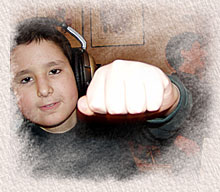

|
|